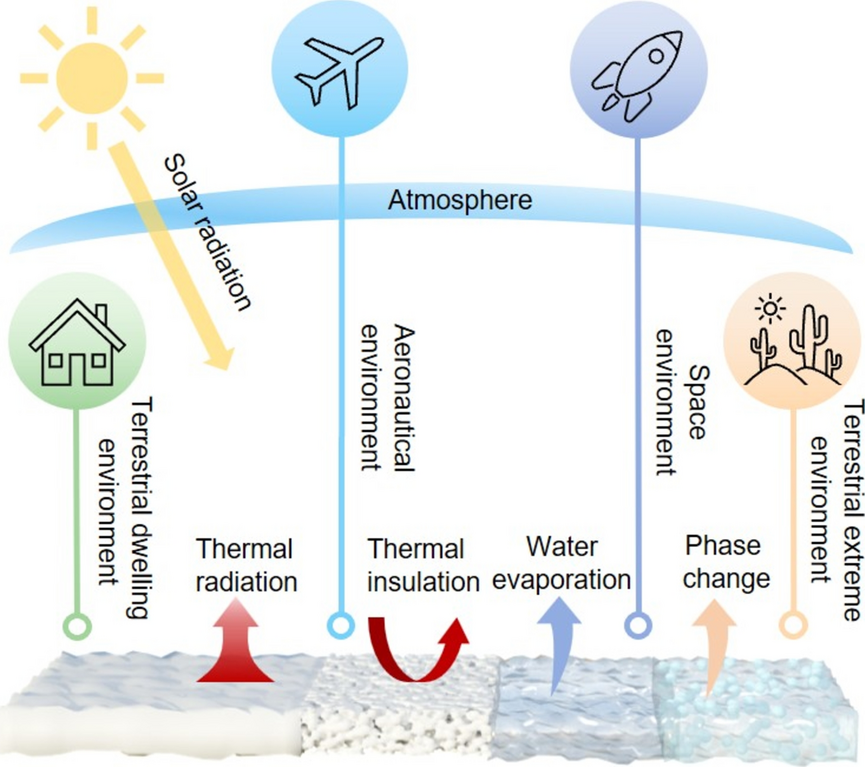
As global temperatures rise and extreme weather events become more frequent, the demand for advanced thermal management technologies has never been more urgent. Researchers from Shanghai Jiao Tong University, led by Prof. Han Zhou and Prof. Di Zhang, have published a comprehensive review on radiative cooling materials designed for extreme environments, offering a roadmap for next-generation cooling solutions that operate efficiently in the harshest conditions on Earth—and beyond.
Why Radiative Cooling Matters in Extreme Environments
Radiative cooling is a passive thermal management strategy that allows surfaces to dissipate heat by emitting infrared radiation directly into space, without consuming energy. In extreme environments—such as deserts, high-altitude aircraft, or outer space—traditional cooling systems often fail due to high temperatures, intense UV radiation, or lack of atmosphere.
This review highlights how micro- and nano-structured materials can be engineered to selectively emit and reflect thermal radiation, enabling efficient cooling even under intense solar irradiance, high humidity, or vacuum conditions.
Key Innovations and Material Strategies
The review systematically explores four major environmental categories:
1. Terrestrial Dwelling Environments
Materials must resist UV, microbes, flames, and pollution while maintaining high mid-infrared (MIR) emissivity in the 8–13 μm atmospheric window.
- Example: A polyoxymethylene (POM) nanotextile that reflects 95% of sunlight and emits 75.7% in the MIR range, while resisting UV and abrasion.
2. Terrestrial Extreme Environments
In deserts or tropical regions, cooling systems must operate under high temperature and humidity.
- Solution: Dual-selective emitters that utilize secondary atmospheric windows (3–5 μm and 16–25 μm), combined with evaporative cooling and phase change materials (PCMs) for enhanced heat dissipation.
3. Aeronautical Environments
Infrared stealth is critical. Materials must emit in non-atmospheric windows (5–8 μm) while suppressing emission in the 8–13 μm range to avoid detection.
- Example: Multilayer metamaterials and photonic crystals that achieve infrared camouflage and radiative cooling simultaneously.
4. Space Environments
In the vacuum of space, materials must withstand UV radiation, cosmic rays, and atomic oxygen erosion, while emitting across the full MIR spectrum.
- Breakthrough: All-inorganic coatings like phosphate geopolymer paints and silica aerogels that maintain optical performance even after proton irradiation or exposure to 1200°C.
Applications and Future Outlook
These materials are not just lab-scale curiosities—they are being integrated into building coatings, personal cooling textiles, aircraft skins, and spacecraft thermal shields. The review also outlines future directions, including:
- Multi-functional materials that combine UV resistance, flame retardancy, antimicrobial properties, and self-cleaning.
- Dynamic spectral tuning for adaptive cooling/heating based on environmental conditions.
- Hybrid cooling systems that integrate radiative, evaporative, and latent heat mechanisms for maximum efficiency.
Conclusion
This comprehensive review provides a strategic framework for designing next-generation radiative cooling materials that can thrive in the most extreme environments. By combining materials science, photonics, and thermal engineering, the authors lay the groundwork for energy-efficient, passive cooling technologies that could revolutionize everything from urban infrastructure to space exploration.
Stay tuned for more cutting-edge research from Prof. Han Zhou and Prof. Di Zhang at Shanghai Jiao Tong University!
Follow the Topic
-
Nano-Micro Letters

Nano-Micro Letters is a peer-reviewed, international, interdisciplinary and open-access journal that focus on science, experiments, engineering, technologies and applications of nano- or microscale structure and system in physics, chemistry, biology, material science, and pharmacy.






Please sign in or register for FREE
If you are a registered user on Research Communities by Springer Nature, please sign in